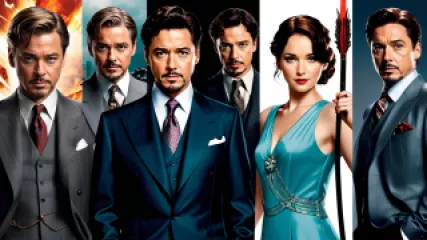Learning Impulsive Decision Making from Famous Characters
Introduction:
Decision-making is an integral part of our daily lives. Whether it's choosing what to eat for breakfast or making important life-altering choices, our decisions shape the course of our existence. However, our decision-making processes are often influenced by cognitive biases and impulsive tendencies that can lead to less than optimal outcomes. In the field of psychology, researchers have extensively studied cognitive biases and behavioral economics to understand how our minds work when making decisions.
In this article, we will explore the fascinating world of impulsive decision-making through the lens of famous characters from books and movies. By examining their actions and thought processes, we can gain valuable insights into our own decision-making patterns and learn how to make more rational choices. So, let's embark on this journey of self-discovery and see what lessons we can glean from these iconic characters.
The Impulsive Decision-Making of Jay Gatsby
Jay Gatsby, the enigmatic protagonist of F. Scott Fitzgerald's "The Great Gatsby," is a character known for his impulsive decision-making. Driven by his relentless pursuit of wealth and the love of his life, Daisy Buchanan, Gatsby often acts without careful consideration of the consequences. His impulsive nature ultimately leads to his downfall.
Gatsby's impulsive decision-making can be attributed to various cognitive biases, such as the optimism bias and the sunk cost fallacy. The optimism bias refers to our tendency to believe that things will turn out positively for us, even in the face of evidence suggesting otherwise. Gatsby's unwavering belief in his ability to win Daisy's love blinds him to the reality of their relationship and the consequences of his impulsive actions.
The sunk cost fallacy is another cognitive bias that Gatsby falls victim to. This bias occurs when we continue investing time, money, or effort into something because we have already invested so much, even if it no longer makes logical sense. Gatsby's relentless pursuit of Daisy, despite her marriage to another man, is a clear example of the sunk cost fallacy. He becomes trapped in a cycle of impulsive decisions driven by his past investment in their relationship.
Lesson Learned: It is essential to recognize and overcome cognitive biases when making decisions. Being aware of biases like the optimism bias and the sunk cost fallacy can help us avoid impulsive choices that may lead to negative outcomes.
The Rational Decision-Making of Sherlock Holmes
Sherlock Holmes, the brilliant detective created by Sir Arthur Conan Doyle, is renowned for his logical and rational approach to problem-solving. Unlike Gatsby, Holmes carefully analyzes evidence and considers all possibilities before making a decision. His ability to detach himself from emotions and biases allows him to arrive at the most objective conclusions.
Holmes's rational decision-making can be attributed to his use of decision-making models, such as the scientific method and deductive reasoning. The scientific method involves systematically gathering evidence, formulating hypotheses, and testing them through observation and experimentation. Holmes applies this method to solve cases, ensuring that his decisions are based on solid evidence rather than assumptions.
Deductive reasoning is another tool in Holmes's arsenal. By using deductive reasoning, Holmes starts with general principles and narrows down to specific conclusions. This logical approach helps him eliminate improbable options and focus on the most likely solution.
Lesson Learned: Applying decision-making models, such as the scientific method and deductive reasoning, can enhance our ability to make rational choices. By gathering evidence, eliminating biases, and considering all possibilities, we can approach decision-making with a clear and logical mindset.
The Overcoming of Cognitive Biases by Katniss Everdeen
Katniss Everdeen, the brave and resourceful protagonist of Suzanne Collins' "The Hunger Games" series, demonstrates tremendous growth in her decision-making abilities throughout the books. Initially driven by survival instincts and emotional impulses, Katniss learns to overcome cognitive biases and make more rational choices as she navigates the treacherous world of the Hunger Games.
One cognitive bias Katniss must overcome is the availability heuristic. This bias occurs when we rely heavily on information that is readily available in our minds, rather than considering a broader range of possibilities. In the Hunger Games arena, Katniss's initial decisions are driven by the immediate threats and dangers she faces. However, as she gains experience and perspective, she learns to consider long-term strategies and alliances.
Another cognitive bias Katniss overcomes is the status quo bias. This bias refers to our preference for maintaining things as they are, even when change may be beneficial. Initially, Katniss is hesitant to challenge the oppressive regime governing Panem. However, as she witnesses the suffering of her fellow citizens and experiences firsthand the injustices of the Capitol, she becomes an active participant in the rebellion, challenging the status quo for the greater good.
Lesson Learned: Overcoming cognitive biases requires self-awareness and a willingness to challenge our preconceived notions. By questioning the availability heuristic and the status quo bias, we can make more informed decisions that align with our values and lead to positive change.
The Impulsive Decision-Making of Tony Stark
Tony Stark, the charismatic billionaire and superhero known as Iron Man, often acts on impulse, driven by his ego and desire for instant gratification. While his impulsive decisions often save the day, they also lead to unintended consequences and put those around him at risk.
One cognitive bias that Stark frequently exhibits is the overconfidence effect. This bias refers to our tendency to overestimate our abilities and the likelihood of positive outcomes. Stark's belief in his technological prowess and his willingness to take risks based on his confidence often lead to impulsive actions that endanger himself and others.
Additionally, Stark demonstrates the influence of the present bias, which causes us to prioritize short-term rewards over long-term benefits. His impulsive decision-making is driven by the desire for immediate gratification and a reluctance to consider the potential consequences of his actions.
Lesson Learned: Recognizing the impact of cognitive biases, such as the overconfidence effect and the present bias, can help us make more thoughtful decisions. By considering the long-term implications and being mindful of our own limitations, we can mitigate the risks associated with impulsive decision-making.
The Importance of Self-Reflection and Growth
Examining the impulsive decision-making of famous characters allows us to reflect on our own decision-making processes. By identifying cognitive biases and understanding their influence, we can become more conscious decision-makers. Just like these characters, we have the capacity for growth and learning from our experiences.
It is crucial to regularly engage in self-reflection and evaluate the factors driving our decisions. By cultivating self-awareness and challenging our biases, we can make more rational choices that align with our values and long-term goals.
In conclusion, learning from famous characters provides valuable insights into the world of impulsive decision-making. Jay Gatsby teaches us about the dangers of cognitive biases and impulsive actions, while Sherlock Holmes demonstrates the power of rationality and logic. Katniss Everdeen shows us the importance of overcoming biases for the greater good, and Tony Stark reminds us of the risks associated with overconfidence and present bias.
By applying these lessons to our own lives, we can navigate the complexities of decision-making with greater wisdom and insight. Remember, every decision we make shapes our future, so let's strive to make choices that lead us toward a more fulfilling and rewarding life.






